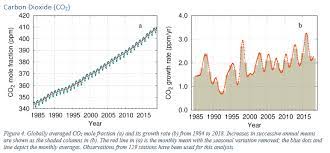
WMO Report: Increase in concentrations of Green House Gases
WMO Report: Increase in concentrations of Green House Gases
Important for Prelims:
Greenhouse gases, World Meteorological Organization (WMO), carbon cycle, COP28 climate summit.
Important for Mains:
GS-3: Concerns regarding greenhouse gas concentration increases, efforts to control greenhouse concentrations.
Nov. 17, 2023
Why in news:
Recently, according to the latest report of the UN's World Meteorological Organization (WMO), there has been a record increase in the concentration of greenhouse gases, which are increasing the average temperature of the Earth by trapping heat in the atmosphere.
- Methane and Nitrous oxide levels increased in 2022 compared to 2021.
- The global average CO2 concentration in 2022 was 417.9 ppm, while in 2021 it was 415.7 ppm.
- However, this rate of increase in CO2 concentrations is slightly lower than the average over the past year and decade due to short-term changes in the carbon cycle.
- There is more than a 99% chance that the year 2023 will be the world's hottest year on record.
Green House Gases:
- According to the US Ocean and Atmospheric Administration, the total warming potential of greenhouse gases has increased by 49 percent from 1990 to 2022. The concentration of carbon has increased by 78 percent.
- According to the organization, the presence, effects and conditions of greenhouse gases are as follows:
Carbon dioxide
- Carbon dioxide accounts for 50 percent of the greenhouse gases and contributes 64 percent to global warming.
- Every year, the ocean absorbs 25 percent of its total emissions and forests absorb 30 percent.
Methane
- It persists in the atmosphere for a decade, contributing 16 percent to warming.
- 40% of methane comes from natural sources like wetlands and termites. 60 percent is produced from human activities such as paddy cultivation, cattle raising, fossil fuel mining, burning of stubble and other organic materials.
Nitrous oxide
- Along with being a greenhouse gas, it is also an ozone depleting gas. The contribution to heat gain is 7%.
- 60 percent of its emissions are coming from sea, soil, biomass and forest burning and 40 percent emissions are from human activities like chemical fertilizers and industrial activities.
COP28 climate summit:
- This summit is scheduled to be held in Dubai from 30 November to 12 December.
- This summit is very important for action on increased concentrations of greenhouse gases as it follows the 2015 Paris Agreement, where countries have committed to limiting global warming to "quite low" two degrees Celsius above pre-industrial levels, an even more ambitious target has been set to limit it to 1.5 degrees Celsius, if possible.
Concerns related to greenhouse gas concentration increase:
- By the end of this century, temperatures are expected to rise by more than 1.5-2 degrees Celsius above pre-industrial levels, as stipulated under the Paris Agreement.
- The Amazon rainforest, which acts as a carbon sink, is being degraded rapidly.
- Due to deforestation and reduced humidity, the capacity of forests around the world to absorb CO2 is losing.
- Given the long lifetime of CO2, it can be said that the effects of this temperature increase will persist for many decades even in the event of zero carbon emissions.
- Rising temperatures will be accompanied by a number of extreme weather events, including intense heat and rainfall, melting ice, sea level rise and ocean acidification with far-reaching socioeconomic impacts.
Efforts to control greenhouse gas concentrations:
Internationally:
Kyoto Protocol:
- The Kyoto Protocol is an international treaty designed to prevent climate change caused by global warming. It commits countries participating in this treaty to reduce greenhouse gas emissions.
Montreal Protocol:
- The Montreal Protocol is an international treaty adopted on 16 September 1987 for the protection of the ozone layer, which is effective from 1 January 1989.
- United Nations Framework Convention on Climate Change
At Indian level:
- National Hydrogen Energy Mission
- Green Hydrogen Blend Project
- India is promoting green hydrogen produced by splitting water molecules using renewable energy.
- Encouraging seaweed based animal feed to reduce methane emitted by animals.
- Launching India Greenhouse Gas Program.
- Launching the National Action Plan on Climate Change.
- Implementing Bharat Stage-VI norms.
- Jawahar Lal Nehru National Solar Mission (January 11, 2010)
- International Solar Alliance (November 30, 2015)
- National Wind Solar Hybrid Policy (2018)
- PM Kusum Yojana (February, 2019)
- Rooftop Solar Scheme (February 1, 2020)
Way forward
- Climate action requires all countries of the world, especially developed countries, to work together.
- There is a need to ensure that all people have access to modern, affordable and reliable facilities and services to control greenhouse gases.
- India should focus on building and strengthening its domestic institutions for climate implementation.
- India should make efforts to implement the long-term principle of ‘Common But Differentiated Responsibility’ (CBDR) in the upcoming climate change talks.
- India needs to reduce coal use by 99% by 2060, especially for power generation, to achieve net zero target by 2070.
- India needs to reduce crude oil consumption by 90% across all sectors between 2050 and 2070.
- India's energy future should be determined keeping in mind the developmental needs and impacts of climate change.
Conclusion:
India is on track to meet the United Nations Convention on Climate Change (UNFCCC) commitment to reduce emissions intensity by 45% below 2005 levels by 2030 to control greenhouse gases.
--------------------------------------------
Mains Exam Question
Review the efforts made across the world including India to prevent the concentration effect of greenhouse gases.